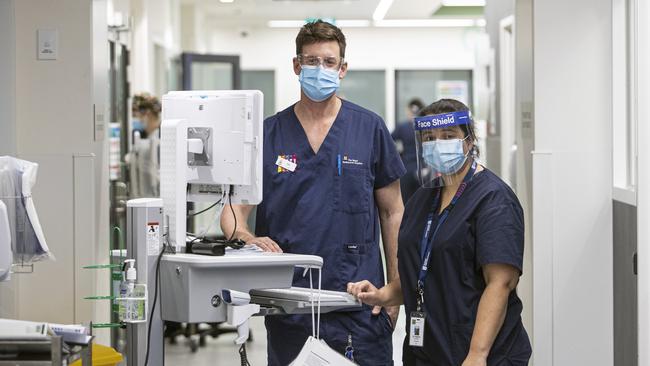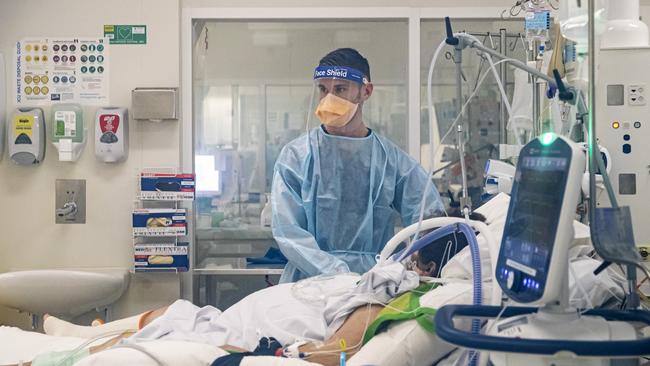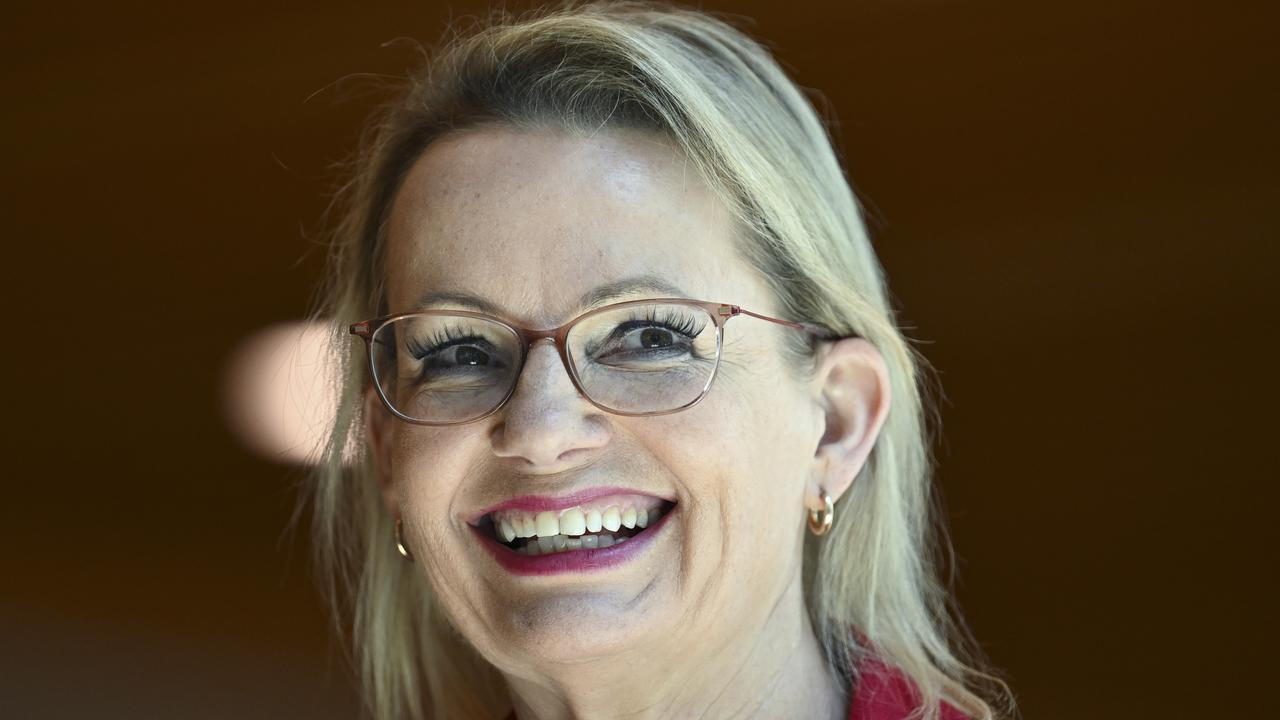A day in ICU where life is more intensive than usual for health workers battling on the frontline
What happens inside an ICU during a pandemic? We track one exhausting day in the life of Royal Melbourne Hospital’s intensive care unit.

Both their iPhone alarms ring well before 6am. Both check messages for overnight emergencies at work. Already they are “on”, the adrenaline starting to flow. Their jobs were high stakes before coronavirus. Now COVID-19 adds a layer of complexity, an additional challenge in one of the nation’s most challenging workplaces.
Dan Hadley, a 38 year-old clinical nurse manager at the Royal Melbourne Hospital’s intensive care unit, tiptoes out his door so as not to disturb his three sleeping kids, all under seven. He drives to a spot about 5km from the hospital, parks, and runs the rest of the way. It clears his head, and he admits to being slightly obsessive about his running times. A quick shower and he’s in his office in Parkville, just north of the CBD well before 7am. Breakfast at his desk while working on his daily planner.
Yasmine Ali Abdelhamid, 37, an intensive care specialist in RMH’s ICU, takes the more regular route of breakfast and coffee as she checks emails, arriving at work also before seven in time to clear some paperwork in her role as the unit’s acting deputy director before the 7.30am ward round.

So far, so routine, but with some of the 30-plus COVID-positive intensive care patients in Victoria in their hands, routine has shifted a long way.
Dr Ali Abdelhamid’s profile of a typical COVID patient serves as a stark warning to us all.
“It’s true our patients are generally older and often with comorbidities, but I have seen people in this ICU who are old but have no other medical issues other than COVID,” she says.
“I’ve seen younger people with COVID in ICU with comorbidities and I’ve seen younger people in here with no other medical issues besides COVID.
“If I can get one message across, it’s that coronavirus can make anyone, anyone, extremely ill.”
Mr Hadley’s first meeting is at 7am, where he is briefed on all patients across the ICU. For Dr Ali Abdelhamid it is at 7.30am, a ward round covering 10 to 12 of the beds, a handover from the nightshift. Running for about 90 minutes, it is multidisciplinary: clinicians, nurses, dietitians, physiotherapists, pharmacists and where necessary others such as social workers. They attend each patient and plan their care for the day. This is the major decision-making meeting for the day.
At full capacity the ICU has 42 beds, with fewer than 10 COVID patients currently, though this may well rise with the increased number of cases in the community.
“For patients with COVID-19 we don’t all enter their room. One member doing the round will go in and assess, and we will communicate from outside the room,” Dr Ali Abdelhamid says.
Entering a COVID patient “hot room” requires the full gamut of personal protective equipment, Mr Hadley says, which is an N95 mask, a face shield, fluid impervious gown and gloves. In other areas of the ICU they wear a surgical mask, face shields and regular scrubs. Mr Hadley changes his shoes entering and leaving the ICU.
Even though RMH is a specialist infectious diseases hospital and ICU protocols have always been extremely strict around PPE, there is a recognition that this virus is far more contagious than others they have previously dealt with. This means an additional layer of vigilance, and an additional level of worry.
“As much as I think we are safe, we’re only as safe as our processes,” Mr Hadley says. “But there’s always an element of worry with anything unknown.”
Dr Ali Abdelhamid is more sanguine. “I can’t speak for everybody. I feel there is a risk there, but I’d say every job has a risk associated with it. And because there has been such an emphasis on safety from the hospital and the department it gives you a level of confidence.
“We do the job in the good times and the bad times, and what can be done to mitigate has been done.”
Mr Hadley says the heightened protections have made working more challenging. “The gear can be annoying. Donning and doffing of PPE has to be done in more places, and more often. You have to wear PPE even in administrative roles, and it’s hot and hard to breathe sometimes, but it’s something we’ve adapted to in order to keep patients and our colleagues safe.”
There is a buddy system for putting on and removing PPE to ensure no contamination, and constant re-education and reinforcement of the protocols.
Dr Ali Abdelhamid says the infection control measures make care in an ICU more complex and PPE more important. “It’s difficult to treat a patient on life-support from 1.5m away,” she says. “They still need to be examined, both from a care side and a human side.”
Both medical professionals attend the 10am bed meeting. Here decisions are made about which patients are in a position to leave ICU for a ward, and whether any treatment options should be changed. They aim to keep it no longer than 15 minutes. Multi-disciplinary meetings may follow, which discuss how to best deal with the needs of a long-term patient. Decisions made here set the path much of the balance of the day.
“This is the time we might also have an education meeting to learn about a new piece of equipment, or there may be an external meeting of one of the hospital committees that you may need to do, which are now all done on Webex,” Mr Hadley says.
“I also spend a lot of time over the day working with a tight-knit team of other managers, whether that be informal meetings or regular phone calls and messages, to ensure all our staff are supported and feel safe and patients are receiving the best care.”
Mr Hadley first thought of being an engineer. Or a paramedic. But he started nursing and loved it. “I had a passion for equipment, and the best place for that is in an ICU. I went straight there after my study and 18 years later I’m still here, although now a lot of my job is on the management side.”
Neither stop long for lunch. It tends to be a quick bite at the desk accompanied by more paperwork. Mr Hadley used to slip out to the gym occasionally but that outlet is closed, so it’s pretty much lunch on the run.
Patients in ICU with COVID are there because they are having trouble breathing. The ones in comparatively better shape will be receiving oxygen through a mask or a nasal prong. If the virus is more severe and the patient is deteriorating the next step is life-support, where they are sedated into unconsciousness and a breathing tube attached to a life-support machine is inserted into the windpipe to deliver oxygen to the lungs. Nursing support in ICU is either at a 1:1 or 1:2 ratio with patients.
“At one stage during the early stages of this spike we had 10 patients with coronavirus on life-support,” Dr Ali Abdelhamid says.
One of the COVID-enforced changes in an ICU is the way families are kept informed and involved in their loved one’s care. Dr Ali Abdelhamid says they were previously welcome to sit in on the afternoon ward round at 3pm, but this communication has to be done in a different way now, mainly through telehealth, for the families of patients with and without COVID.
Dr Ali Abdelhamid is an intensivist, one of the most difficult of the medical specialties, one that cares for the sickest patients in a hospital when they become critically ill. It requires at least six years of specialty training after a medical degree and an internship.
“I chose this because I wanted to be the doctor that was helping a patient as they were deteriorating. I always felt I didn’t want patients to get to a certain level of being critically ill and then handing them over to someone else,” she said. “It’s also very different from a practice out of an office with patients. Here you are always part of a team, a community working for the same thing, to do your best for people.”
She says the ongoing outbreak creates an enormous logistical challenge for an ICU, especially in the planning. “From here patients are potentially going to come in not one or two at a time, but potentially in a big rush. This will be an enormous resourcing challenge.” “The lessons we will learn about how to make our system work when it’s under strain will be so important.”
The work day officially ends around 5.30 with the handover to the evening shift, but both will regularly do an hour or more extra paperwork before heading home.
Mr Hadley runs back to his car. “It’s downhill so my time is quicker,” he says. but admits that even when everything runs smoothly he might still miss dinner with the kids. “I make up for it on my days off,” he says.
Melburnians will identify with Dr Ali Abdelhamid’s post-work world at the moment. “I’ll probably go home and watch some trashy TV. What else do you do in lockdown?”








To join the conversation, please log in. Don't have an account? Register
Join the conversation, you are commenting as Logout